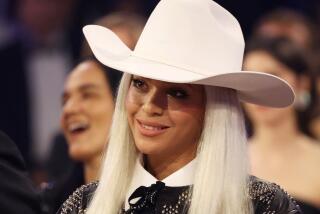Essential albums of 2015: Bjork, Kendrick and 8 others on the edge of pop
- Share via
Embarking on a mid-year rundown of 2015’s best pop albums so far is as much an exercise in mix-and-match diplomacy as it is a definitive truth. Within the various portals of “popular music” in 2015 are so many sounds, approaches, accents, instrumental varieties and ear-popping engineering feats that one tilt of the kaleidoscope yields wildly divergent patterns. I’ve constrained myself to focus on voices pushing at the edges of so-called popular music.
Below, 10 essential records released so far in 2015, in alphabetical order:
Alabama Shakes, “Sound & Color” (ATO Records). The second album from Alabama Shakes eases in, as if to beguile its way into listeners’ hearts rather than storm in uninvited. A breathtaking statement that expands on the band’s rock ‘n’ soul breakthrough debut in ways few could have predicted, this is, at its base, a rock record but in ways that sound totally Now. That’s due in part to Blake Mills’ crystalline production, one that errs on the side of adventure at the expense of Muscle Shoals-style throwback. At the center, though, is singer and guitarist Brittany Howard, an undeniable force equally gifted at song craft and vocal performance.
Bjork, “Vulnicura” (One Little Indian). It’s tempting to describe “Vulnicura” as occupying its own virtual reality, except the theme of the Icelandic artist’s album is devastatingly real. Its focus is on her relationship with the visual artist Matthew Barney, and the nine compositions trace its beginnings through to its (spoiler alert) dissolution. Abstract synthetic compositions interwoven with mournful strings move through various stages with a lyrical sharpness uninterested in tact. The result is a record that’s so filmic that when it’s over your senses will feel heightened, and you might need a few moments to adjust to daylight.
Damaged Bug, “Cold Hot Plumbs” (Castleface). “Underground rock” in 2015 is so chaotic that whole realms thrive outside the purview of all but the most focused scenesters. The music made by Damaged Bug, the moniker of musician (founder of Thee Oh Sees) and visual artist John Dwyer, lacks commercial sheen, is fuzzy with grit and a general weirdness that screams No Sellout. But it’s a durable creation, one rich with ‘60s psychedelic accents and ‘80s new wave appeal.
Donnie Trumpet & the Social Experiment, “Surf” (self-released). Amid the gang violence and poverty of Chicago’s South Side, a collection of young soul, funk, hip-hop and jazz musicians has converged as the Social Experiment. Among the most prominent members are Chancelor Bennett, a.k.a. Chance the Rapper, and his frequent collaborator Donnie Trumpet (Nico Segal). Trumpet and company are Chance’s touring band, and “Surf” offers a platform upon which all of them thrive. Chance is mostly the focus, as it should be; he’s equally skillful as a rapper, singer and bandleader. A snapshot sample of their skills can be found on “Sunday Candy,” as lovely an ode to a grandmother as you’re likely to hear.
Holly Herndon, “Platform” (4AD). “Platform” is a curious record, composed entirely on laptop by sound artist and composer Herndon. She has studied composition at Mills College and sound at Stanford University’s Center for Computer Research in Music and Acoustics, and her skills are strikingly obvious. Through voice manipulation, a master’s understanding of her instrument and compositional skills to match, Herndon revels within a sonic space in which the human voice is ridiculously elastic and malleable, and synthetic beats glow with warmth.
Kendrick Lamar, “To Pimp a Butterfly” (Top Dawg Entertainment). A statement of purpose from a Los Angeles original, Lamar’s third album already has the makings of a classic, one courtesy of the most skilled, thoughtful and lyrically accomplished voice in contemporary hip-hop. A focused record created by musicians brainstorming in a studio, “To Pimp a Butterfly” is both an organic funk-jazz record and a new-breed hip-hop jam. Hot singles such as “i,” “The Blacker the Berry” and “King Kunta” explode with top-track energy and smart explorations of politics both private and protest-worthy, while tracks like “These Walls” and album-closer “Mortal Man” roam the experimental depths.
Natalie Prass, “Natalie Prass” (Spacebomb/Startime International). If we’re talking ear-worm loops, Prass’ self-titled debut of confident, memorable pop songs is my most spun record of the year. “My Baby Don’t Understand Me” mixes a mournful ode to disinterest that erupts at key moments with brass and string accents. “Christy” feels like a lost show tune from an unsung musical about lust, betrayal and jealousy, with Prass and co-producer/arranger Matthew E. White steering it onto a divergent path that exposes a whole new vista. That happens repeatedly on “Natalie Prass.”
Chris Stapleton, “Traveller” (Mercury/Universal). Nashville songwriter Stapleton wanders the terrain where country music and soul intersect, an area occupied at various times by Ray Charles, the Band, Steve Earle and Willie Nelson. “Traveller” marks a kind of arrival; Stapleton is young, bearded and soulful, understands the importance of whiskey to his chosen field and sounds like a man in it for the long haul. “Daddy Doesn’t Pray No More” ponders faith, while “Why I Cry” is a wrenching weeper filled with angst and revelation.
Sufjan Stevens, “Carrie & Lowell” (Asthmatic Kitty). An emotional exploration of family, addiction, sacrifice and love, this is the pop composer and songwriter Stevens’ autobiographical look inward. It’s named after his late mother, a life-long addict who left care of her son to Stevens’ father as she descended further into addiction; and Stevens’ stepfather. A gentle rock album that hints at the work of Nick Drake and Elliott Smith, “Carrie & Lowell” highlights an artist who explores regret and loss, who uses his muse as a tool for mourning. He delves into the confusion of his upbringing with unflinching clarity, attempting to come to terms with both his mother’s love and her self-destructiveness.
Kamasi Washington, “The Epic” (Brainfeeder). Is this breathtaking triple album from the L.A. jazz saxophonist and composer an outlier on this list? So what. “The Epic” is a fluid mix of free jazz, post-bop, fusion and hip-hop. An overwhelming display of rhythm, brass, strings, voices and keyboards, it’s also a tough record to crack. The scope only fully revealed itself to me after seeing the band live at the Regent. Since then, though, the creation has more than lived up to its name.
More to Read
The biggest entertainment stories
Get our big stories about Hollywood, film, television, music, arts, culture and more right in your inbox as soon as they publish.
You may occasionally receive promotional content from the Los Angeles Times.










